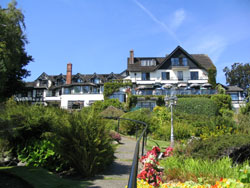The University of British Columbia has a drop-in centre downtown in Vancouver’s East side called the Learning Exchange where it provides educational opportunities to people who live and work in Vancouver’s Downtown Eastside and other inner-city communities.
Vancouver’s Downtown East Side is an inner city neighbourhood that has been experiencing problems with drug addiction and prostitution for many years. The area consists of several diverse neighbourhoods, including Strathcona, Chinatown, and Gastown, as well as the central area around Main and Hastings. The Downtown Eastside is currently facing significant social, economic and health-related issues. While there are undeniable problems, the community also has significant strengths. And, important community-building work is being undertaken and some of this important work is done by the UBC Learning Exchange.

Bridge at the foot of Main Street
The Learning Exchange provides opportunities for UBC students to develop an understanding of society through first-hand volunteer work and promotes the formation of partnerships between people at UBC and people in the Downtown East Side and other inner-city communities that make the sharing of expertise and resources possible. The program started very small and still has a very tight budget, but today more than 800 UBC students volunteer here in a variety of community assistance groups.
10 people from the Servas conference went downtown to participate in a learning experience involving a self-guided tour, and our young local expert Francy spent about 90 minutes with us, exploring what we knew or had heard about the neighbourhood, the various media stereotypes, what type of people lived there and why and what was being done to help this community.
We learned that the community is actually quite diverse, not only does it include people dealing and using drugs as well as sex trade workers, the area also houses new immigrants, social service personnel, artists and students. Even seniors and families live here and in one coop housing project, built around a central courtyard, the single and older people live on the outside of the complex to provide protection, while the families with young children live on the inside so the young ones can play safely in the courtyard .
The Downtown East Side is one of the few areas in Vancouver that still has affordable housing prices. We found out that many of the people in the area take on short-term or transient type of work assignments in labour pools, and many of them work as “binners”, collecting metal cans and glass bottles from garbage containers which then get reclaimed in local recycling facilities. In Vancouver the sight of people going through garbage bins is very common, even in the pristine suburban campus of UBC, and this activity is also referred to as “dumpster-diving”. We realized that these people perform an important societal service by diverting recyclable materials away from the landfills back into reprocessing facilities.
The main drugs represented in this area are heroine, crack and crystal meth, and Francy explained that many of the area’s inhabitants live very nocturnal lives and that the mornings can be fairly quiet. After exploring the socio-economic background of this neighbourhood we were given a safety briefing which included practical advice such as treating people respectfully and looking them in the eye, even if they are requesting money from you, politely declining if someone mistakes you for a sex-trade worker, keeping valuables out of sight and similar issues. I decided to leave my entire purse and camera at the drop-in centre as did several other members of our group.

Buildings in Downtown East Side Vancouver




